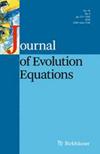三维纳维-斯托克斯方程和纳维-斯托克斯-科里奥利方程在 $$ \dot{H}^{\frac{1}{2}}$ 中的代数衰减率
IF 1.2
3区 数学
Q1 MATHEMATICS
引用次数: 0
摘要
临界空间 \(\dot{H} 中纳维-斯托克斯方程和纳维-斯托克斯-科里奥利方程解的衰减率的代数上限^{\frac{1}{2}}(\mathbb {R}^3)\) 是用傅立叶分裂法推导出来的。根据初始数据的衰减特性进行估计,得出具有代数衰减的解,并详细说明了线性和非线性部分所起的作用。证明纯粹是在临界空间进行的,因为解没有(L^2 (\mathbb {R}^3))估计值。这是第一次使用这种方法来获得非线性方程在临界空间的衰减边界。本文章由计算机程序翻译,如有差异,请以英文原文为准。
Algebraic decay rates for 3D Navier–Stokes and Navier–Stokes–Coriolis equations in $$ \dot{H}^{\frac{1}{2}}$$
An algebraic upper bound for the decay rate of solutions to the Navier–Stokes and Navier–Stokes–Coriolis equations in the critical space \(\dot{H} ^{\frac{1}{2}} (\mathbb {R}^3)\) is derived using the Fourier splitting method. Estimates are framed in terms of the decay character of initial data, leading to solutions with algebraic decay and showing in detail the roles played by the linear and nonlinear parts. The proof is carried on purely in the critical space, as no \(L^2 (\mathbb {R}^3)\) estimates are available for the solution. This is the first instance in which such a method is used for obtaining decay bounds in a critical space for a nonlinear equation.
求助全文
通过发布文献求助,成功后即可免费获取论文全文。
去求助
来源期刊
CiteScore
2.30
自引率
7.10%
发文量
90
审稿时长
>12 weeks
期刊介绍:
The Journal of Evolution Equations (JEE) publishes high-quality, peer-reviewed papers on equations dealing with time dependent systems and ranging from abstract theory to concrete applications.
Research articles should contain new and important results. Survey articles on recent developments are also considered as important contributions to the field.
Particular topics covered by the journal are:
Linear and Nonlinear Semigroups
Parabolic and Hyperbolic Partial Differential Equations
Reaction Diffusion Equations
Deterministic and Stochastic Control Systems
Transport and Population Equations
Volterra Equations
Delay Equations
Stochastic Processes and Dirichlet Forms
Maximal Regularity and Functional Calculi
Asymptotics and Qualitative Theory of Linear and Nonlinear Evolution Equations
Evolution Equations in Mathematical Physics
Elliptic Operators

 求助内容:
求助内容: 应助结果提醒方式:
应助结果提醒方式:


